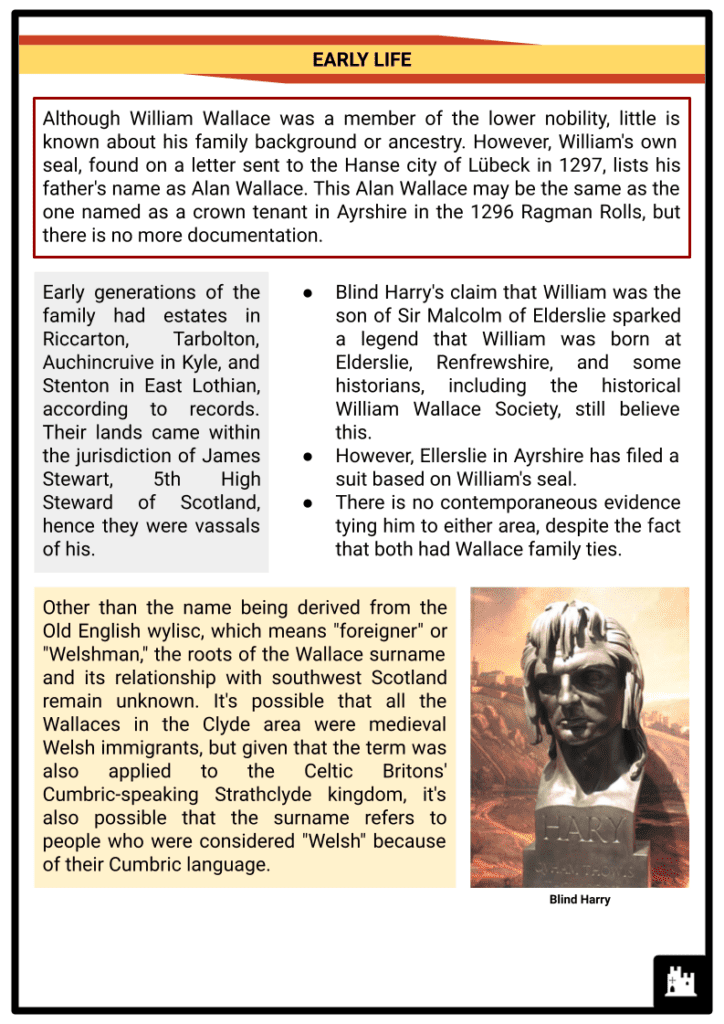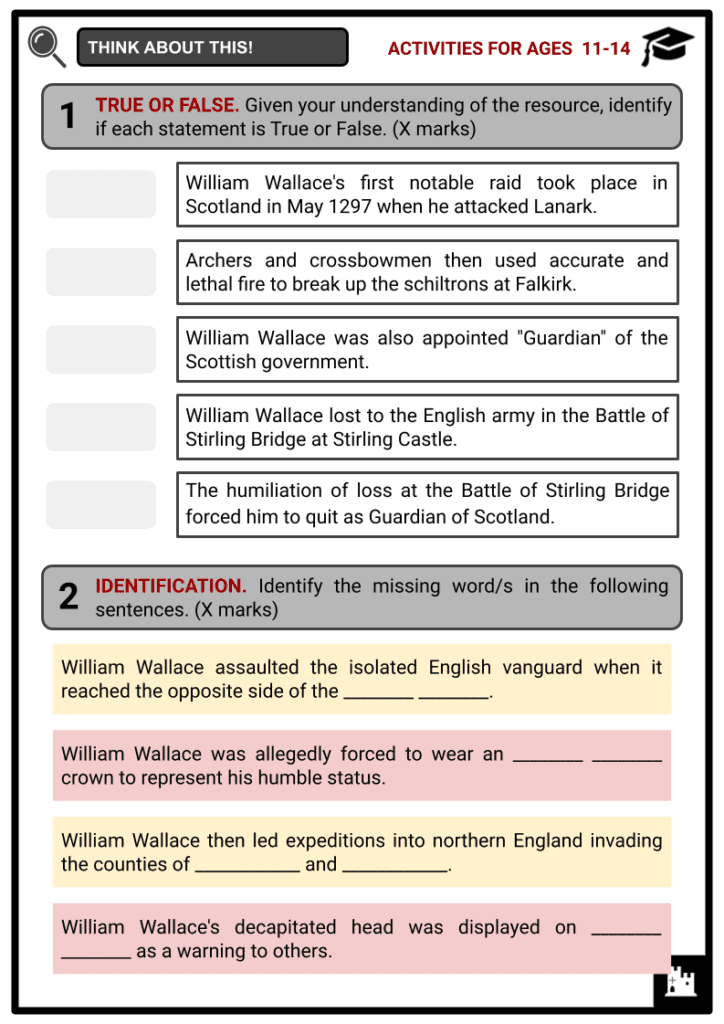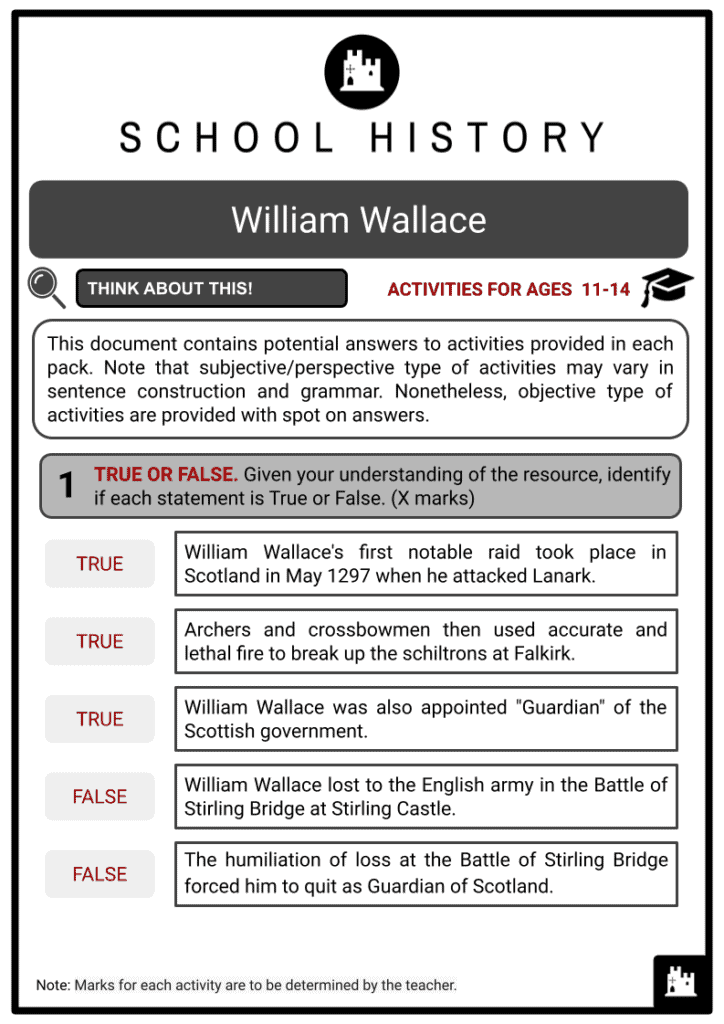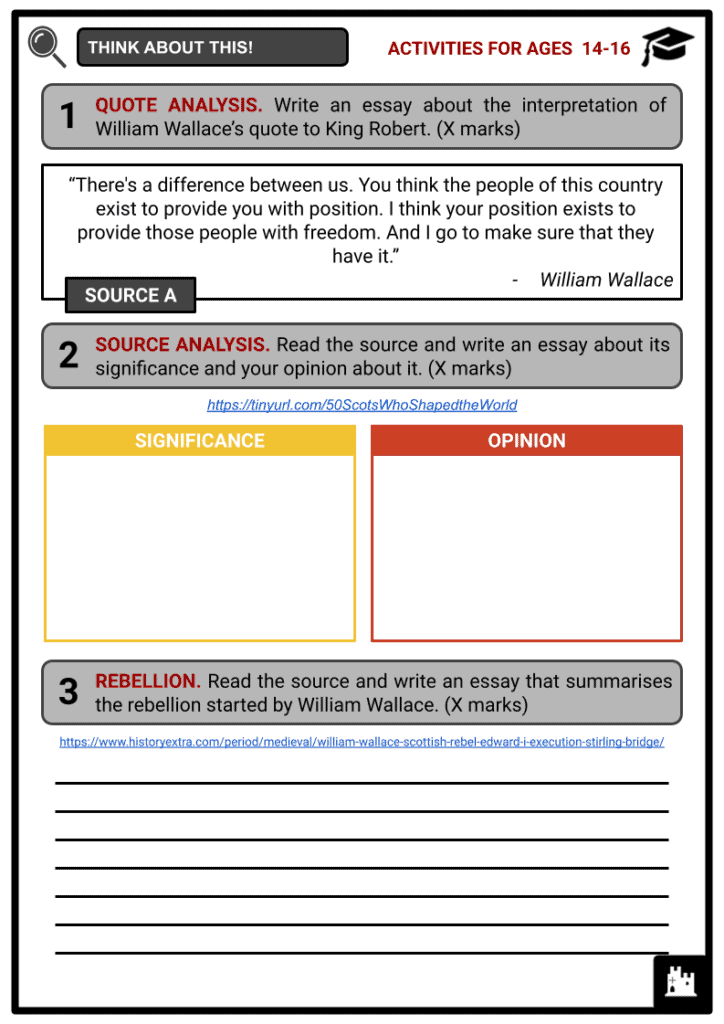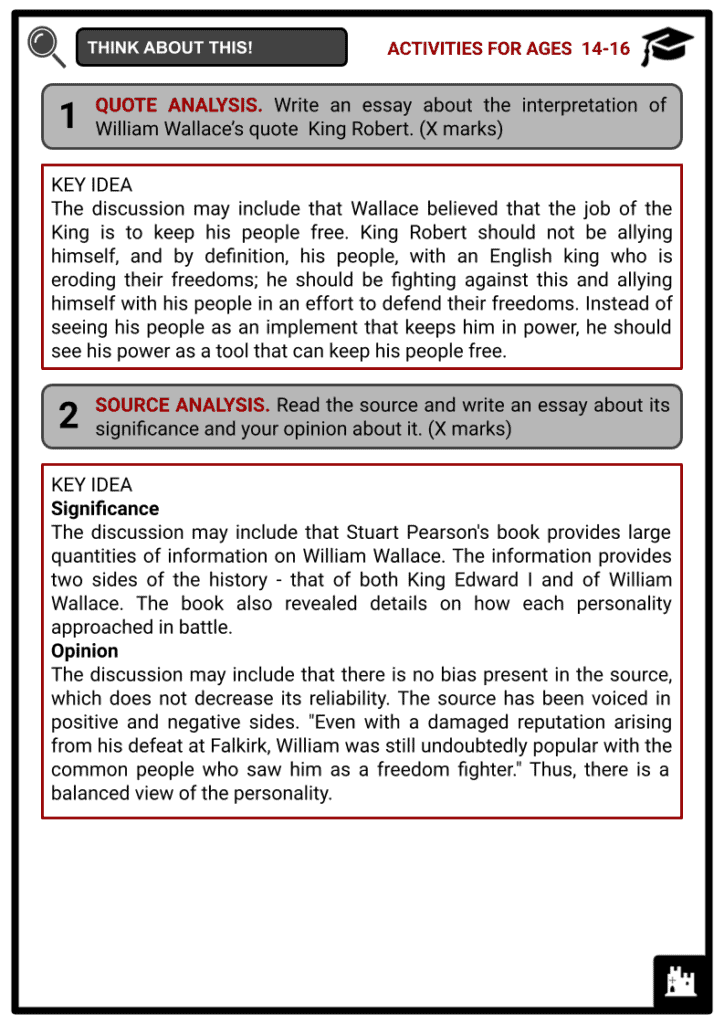Download William Wallace Worksheets
Do you want to save dozens of hours in time? Get your evenings and weekends back? Be able to teach about William Wallace to your students?
Our worksheet bundle includes a fact file and printable worksheets and student activities. Perfect for both the classroom and homeschooling!
Table of Contents
Add a header to begin generating the table of contents
Summary
- Early Life
- Battles Fought
- Execution and Legacy
Key Facts And Information
Let’s know more about William Wallace!
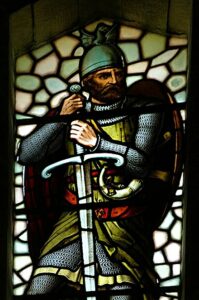
William Wallace was a Scottish knight who became one of the main leaders on the First War of Scottish Independence. He led the Scottish rebellion against Edward I and inflicted a famous defeat on the English army at Stirling Bridge. William was also appointed as Guardian of Scotland and served until his defeat at the Battle of Falkirk. William Wallace is remembered as a patriot and national hero.
EARLY LIFE
- Although William Wallace was a member of the lower nobility, little is known about his family background or ancestry. However, William's own seal, found on a letter sent to the Hanse city of Lübeck in 1297, lists his father's name as Alan Wallace. This Alan Wallace may be the same as the one named as a crown tenant in Ayrshire in the 1296 Ragman Rolls, but there is no more documentation.
- Early generations of the family had estates in Riccarton, Tarbolton, Auchincruive in Kyle, and Stenton in East Lothian, according to records. Their lands came within the jurisdiction of James Stewart, 5th High Steward of Scotland, hence they were vassals of his.
- Blind Harry's claim that William was the son of Sir Malcolm of Elderslie sparked a legend that William was born at Elderslie, Renfrewshire, and some historians, including the historical William Wallace Society, still believe this.
- However, Ellerslie in Ayrshire has filed a suit based on William's seal.
- There is no contemporaneous evidence tying him to either area, despite the fact that both had Wallace family ties.
- Other than the name being derived from the Old English wylisc, which means "foreigner" or "Welshman," the roots of the Wallace surname and its relationship with southwest Scotland remain unknown. It's possible that all the Wallaces in the Clyde area were medieval Welsh immigrants, but given that the term was also applied to the Celtic Britons' Cumbric-speaking Strathclyde kingdom, it's also possible that the surname refers to people who were considered "Welsh" because of their Cumbric language.
BATTLES FOUGHT
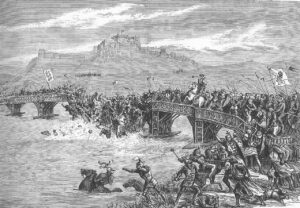
- Wallace's first notable raid took place in Scotland in May 1297, when he attacked Lanark with a group of about 30 men. This invasion was said to be in retaliation for an attack on Wallace's sweetheart Marion and the death of a number of Scottish lords by English soldiers, according to legend. The raid murdered William Heselrig, the English sheriff of Lanark. Wallace and his warriors returned to the safety of the Highlands after more successful attacks on Scone and other English garrisons between the rivers Forth and Tay.
- On 11 September 1297, William Wallace defeated an English army in the Battle of Stirling Bridge at Stirling Castle in central Scotland. The English army, headed by John de Warenne, Earl of Surrey, was substantially bigger than the Scottish force, with at least 300 heavy cavalry. Wallace and Sir Andrew Moray of Bothwell, who had been conducting a separate uprising in Scotland's north, commanded the Scots. Legend has it that during the traditional pre-battle negotiations, William boldly proclaimed to the English representatives:
- “Go back and tell your people that we have not come for the benefit of peace, but are ready to fight, to avenge ourselves and to free our kingdom.”
- Wallace assaulted the isolated English vanguard when it reached the opposite side of the Forth River, using the confines of a narrow bridge that partially barred the opposing army's approach. When they were forced back to the bridge, it crumbled beneath the weight of the troops, and many drowned in the river, their armour weighing them down.
- According to some accounts of the conflict, either the Scots purposefully destroyed the bridge, or the English did it to keep the Scots from chasing them back across the river. Whatever the specifics, the result was clear: a landslide triumph for Scotland. The conflict claimed the lives of around 100 English knights, including Sir Hugh de Cressingham, Edward's treasurer in Scotland, who was cut to bits on Stirling Bridge. Cressingham's skin is said to have been used to construct sporrans and sword belts for the victorious.
- Wallace then led expeditions into northern England, invading the counties of Northumberland and Cumberland and laying siege to the strongholds of Alnwick and Carlisle. He and Moray were so sure in their control of their kingdom that they despatched letters to businessmen in Lübeck and Hamburg in 1297, advising them that it was safe to restart foreign commerce with Scotland. Wallace was knighted in March 1298, most likely by Robert the Bruce, Earl of Carrick and future King of Scotland.
- Wallace was also appointed "Guardian" of the Scottish government and commander-in-chief of the Scottish forces. These honours demonstrate that Wallace was not a commoner, but rather a man with strong ties to the existing Scottish nobility.
- In 1298, Edward I personally led an army across the frontier. Wallace had been gradually retiring north, avoiding a direct encounter and using a scorched earth strategy to pull Edward's army further into Scotland, where his shortage of supplies would become a significant logistical problem. On 22 July 1298, the two armies eventually met in the Battle of Falkirk.
- The Scottish spearmen who had been stationed in front of Callendar Wood in their usual battle line of four schiltroms were routed by Edward's army, which included huge contingents of the much-feared longbow archers and English cavalry.
- Edward had assaulted the enemy from two directions, causing a panicked retreat by the tiny Scottish cavalry force.
- Archers and crossbowmen then used accurate and lethal fire to break up the schiltrons.
- Around 20,000 Scots were slaughtered, whereas just 2,000 English were killed. Most of the Scottish nobility survived to fight another day, which is significant.
- Wallace fled the victorious army, but the humiliation of loss forced him to quit as Guardian of Scotland.
EXECUTION AND LEGACY
- According to some medieval chroniclers, Wallace was ultimately apprehended in Glasgow on 5 August 1305, owing to disloyal companions. The most sought man in Scotland was hauled to Westminster Hall in London to face charges of being a traitor to the Crown. Wallace was allegedly forced to wear an oak leaf crown to represent his humble status as an outlaw. Wallace was accused of pushing Scotland's loyalty to England's nemesis France, of killing innocent men, women, and children, including clergy, during raids in northern England, and of leading soldiers against the English Crown.
- The Scotsman denied the accusations and said that he owed only devotion to his own monarch, John Balliol, who had been ousted. After being found guilty of treason, Wallace received the most severe death punishment an English court could hand down: he was hung, drawn, and quartered on 23 August. Wallace was first stripped naked and carried through the streets of London by his heels behind a horse. When he arrived in Smithfield, he was hung but was removed from the noose just as he was about to die.
- His intestines were taken from his body while he lay on a bench, and he was then beheaded and his body split into four parts. Wallace's head was displayed on London Bridge as a warning to others, while the other four parts of his body were sent to Aberdeen, Berwick, Newcastle, and Stirling, the location of his great triumph.
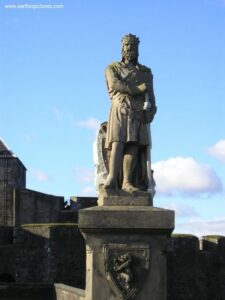
- William Wallace was gone but not forgotten, and his legend grew due largely to epic and highly romanticised ballads as ‘The Acts and Deeds of Sir William Wallace, Knight of Elderslie’, written by either Henry the Minstrel or Blind Harry. This vibrant ballad is the inspiration for the 1995 film Braveheart. ‘The History of William Wallace’, a significant history of Wallace's life, was written in the 16th century.
- Wallace's exploits were commemorated with the construction of a Gothic monument at Stirling in the 1860s. The tower, which is still standing at a height of 67 meters, is a sight to behold. Finally, fine statues of William Wallace and Robert the Bruce, two of Scotland's finest warriors, stand on each side of Edinburgh Castle's gatehouse, which is still the symbolic heart of the country they fought so hard to maintain free of foreign rule.


